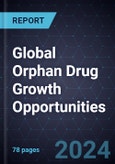Reduced Exclusivity and Increased Competition will Drive Demand for More Efficient R&D and Digital Solutions
This study provides critical insights into the global orphan drug (OD) industry and highlights growth opportunities, revenue, regulatory changes, and technology trends influencing growth.
Approximately 5% of rare diseases (RDs) have received US FDA approval for a drug, while up to 15% of RDs have at least 1 drug that exhibits potential in terms of disease treatment or prevention. The growing number of unaddressed RD needs is a major catalyst for R&D. There is a need for novel medicine to treat RDs that currently have limited therapeutic choices. Recent advancements in precision medicine and informatics, such as big data analytics, multi-omics, nanomedicine, gene-editing techniques, and next-generation diagnostics, have created opportunities to develop specific and individualized therapies for RDs. The convergence of cancer and RDs is becoming evident. Precision oncology and tailored medicine for rare tumors are emerging as prominent themes in the discipline, facilitating the OD industry’s expansion.
Various techniques are used to develop ODs, mainly due to the rise of R&D in personalized medicine, including nucleic acid drugs, gene therapies, cell therapies, and engineered proteins. Small and medium-sized enterprises (SMEs) develop more than half of ODD medication because they benefit from lower prices for scientific assistance, pre- and post-authorization processes, and marketing authorization applications. The early investments obtained from venture capitalists buoy the momentum.
RD treatment access has improved with OD policies, benefiting local and global populations. These actions showcase countries' commitment to public health and research, boosting probable partnerships and investments. Healthcare systems face increasing requirements to contain present and future healthcare spending. Payers are diligently scrutinizing medicine costs and patient access levels to guarantee optimal equilibrium. Healthcare plan sponsors are considering their next move as governments contemplate Orphan Drug Act changes and the impact of the Inflation Reduction Act (IRA).
Key Issues Addressed:
- How much revenue will the global OD industry generate in 2028?
- Which segments will influence revenue growth rate?
- What challenges do patients face in their RD journeys?
- Which business models, technologies, and trends must stakeholders and participants watch during the forecast period?
- What are the major OD growth opportunities?
Table of Contents
Companies Mentioned (Partial List)
A selection of companies mentioned in this report includes, but is not limited to:
- FDA
- UCB








